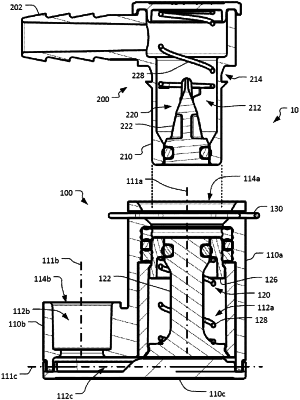| CPC F16L 37/35 (2013.01) [F16L 37/086 (2013.01); F16L 37/53 (2013.01); F16L 33/30 (2013.01); F16L 37/34 (2013.01); Y10T 137/87949 (2015.04)] | 17 Claims |

|
1. A fluid coupling device comprising:
a housing defining an internal space and comprising:
a first housing portion that defines a first internal space portion and a first end opening;
a second housing portion that defines a second internal space portion and a second end opening; and
a third housing portion that is formed separately from the first and second housing portions and then coupled to the first and second housing portions to define a third internal space portion there between; and
a valve assembly coupled to the housing and comprising a valve stem and a valve sleeve, wherein the valve assembly is reconfigurable between: (i) a first arrangement in which a fluid flow path between the first and second end openings is open, and (ii) a second arrangement in which the valve assembly blocks the fluid flow path,
wherein the third housing portion is disposed at a closed end of the fluid coupling device,
wherein a first portion of the fluid flow path extends through the first internal space portion, wherein a second portion of the fluid flow path extends through the second internal space portion, wherein a third portion of the fluid flow path extends through the third internal space portion, and wherein the third portion of the fluid flow path interconnects the first and second portions of the fluid flow path, and
wherein a cross-sectional area of the third internal space decreases along a direction from an end of the third housing portion that is coupled to the first housing portion to an end of the third housing portion that is coupled to the second housing portion.
|